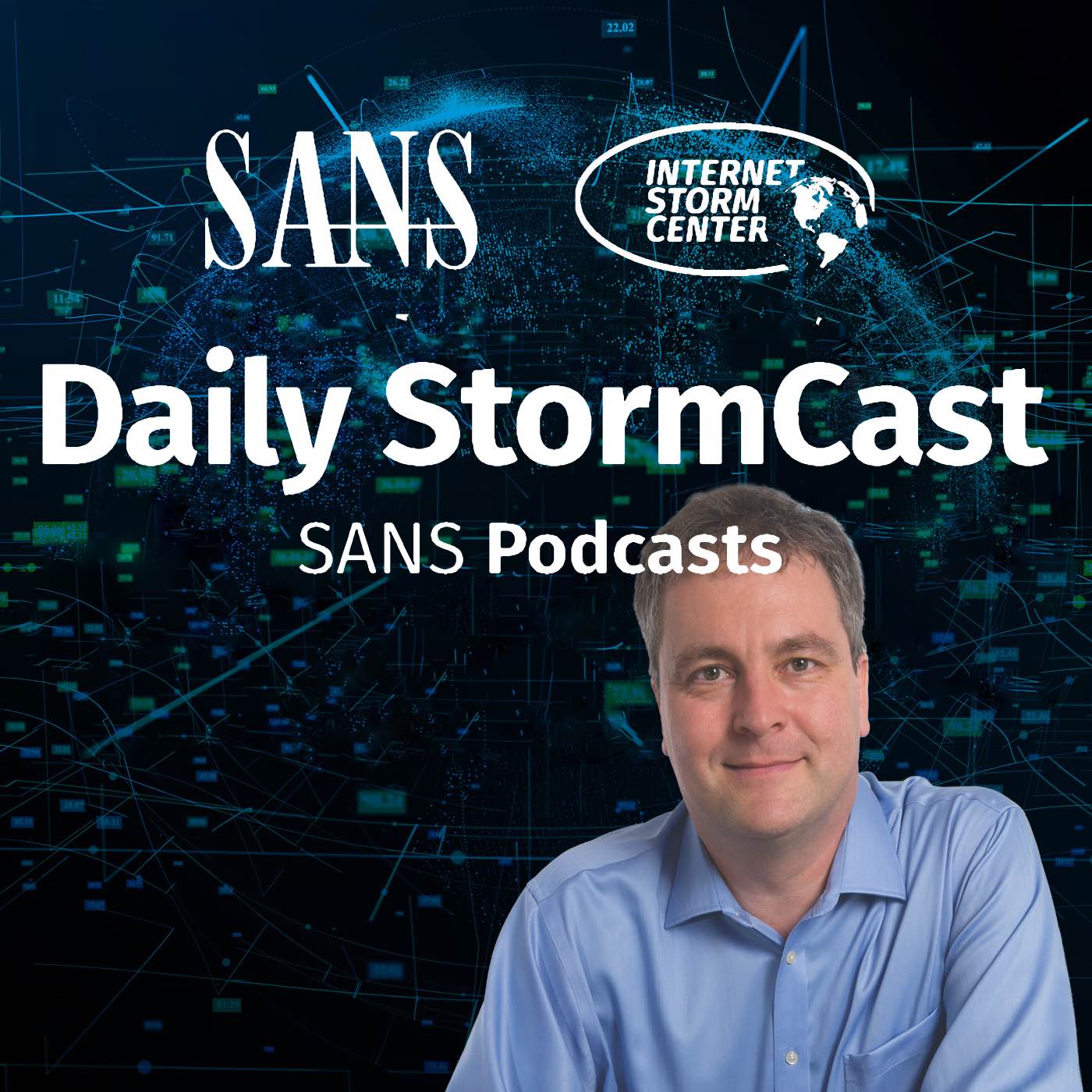Handler on Duty: Didier Stevens
Threat Level: green
Podcast Detail
SANS Internet Stormcast Feb 5th 2025: Feed Updates and Rosti; Resurrecting Dead S3 Buckets; Let's Encrypt Changes; Edge Device Security
If you are not able to play the podcast using the player below: Use this direct link to the audio file: https://traffic.libsyn.com/securitypodcast/9310.mp3

Feed Updates and Rosti; Resurrecting Dead S3 Buckets; Let's Encrypt Changes; Edge Device Security
00:00
My Next Class
| Application Security: Securing Web Apps, APIs, and Microservices | Orlando | Mar 29th - Apr 3rd 2026 |
| Network Monitoring and Threat Detection In-Depth | Amsterdam | Apr 20th - Apr 25th 2026 |
Some Updates to Our Data Feeds
We made some updates to the documentation for our data feeds, and added the neat Rosti Feed to our list as well as to our ipinfo page.
https://isc.sans.edu/diary/Some%20updates%20to%20our%20data%20feeds/31650
8 Million Request Later We Meade the Solarwindws Supply Chain Attack Look Amateur
While the title is a bit of watchTowr hyperbole, the problem of resurrecting dead S3 buckets back to live is real and needs to be addressed. Boring solutions will help not becoming an exciting headline.
https://labs.watchtowr.com/8-million-requests-later-we-made-the-solarwinds-supply-chain-attack-look-amateur/
Let's Encrypt Ending Expiration Emails
Let's Encrypt will no longer send emails for expiring certificates. They suggest other free services to send these emails for you
https://letsencrypt.org/2025/01/22/ending-expiration-emails/
Guidance and Strategies Protect Network Edge Edvices
CISA and other agencies created a guidance document outlining how to protect edge devices like firewalls, vpn concentrators and other similar devices.
https://www.cisa.gov/resources-tools/resources/guidance-and-strategies-protect-network-edge-devices
Discussion
New Discussions closed for all Podcasts older than two(2) weeks
Please send your comments to our Contact Form
| Application Security: Securing Web Apps, APIs, and Microservices | Orlando | Mar 29th - Apr 3rd 2026 |
| Network Monitoring and Threat Detection In-Depth | Amsterdam | Apr 20th - Apr 25th 2026 |
| Application Security: Securing Web Apps, APIs, and Microservices | San Diego | May 11th - May 16th 2026 |
| Network Monitoring and Threat Detection In-Depth | Online | Arabian Standard Time | Jun 20th - Jun 25th 2026 |
| Network Monitoring and Threat Detection In-Depth | Riyadh | Jun 20th - Jun 25th 2026 |
| Application Security: Securing Web Apps, APIs, and Microservices | Washington | Jul 13th - Jul 18th 2026 |
| Application Security: Securing Web Apps, APIs, and Microservices | Las Vegas | Sep 21st - Sep 26th 2026 |
Podcast Transcript
Hello and welcome to the Wednesday, February 5th, 2025 edition of the SANS Internet Storm Center's Stormcast. My name is Johannes Ullrich and today I am recording from Jacksonville, Florida. Today I updated some of the documentation around the website. There are a good number of data feeds that we either create in-house or that we pull from other public sources. And these data feeds are often mentioned, for example, when you're looking up an IP address and one of the IP addresses you're looking up shows up in one of these data feeds. It will be listed in the IP info page. But we never really documented well what these shortcuts, these acronyms we're using actually mean. So this has been fixed now with a couple of additional links throughout the pages that will probably be expanded as I find more opportunities to do so. And the diary that I wrote today does explain a little bit sort of what we are doing here. Again, our API is free to use if you would like to download any of these thread feeds. Just understand that they're not to be supposed to be used as a block list. I actually prefer to call them data feeds instead of thread feeds. I messed it up sometimes myself a little bit. The reason I call them data feeds is that, you know, for example, we have feeds of public NTP servers, which are not malicious. But sometimes it's nice to know that an IP address that you're investigating is associated with the public NTP server, because that could explain some of the traffic that you are seeing. You also have like top level domain servers that you probably definitely don't want to block, but they sometimes do show up in some block lists that are sampled somewhat carelessly, because, well, they're often used for DNS lookups, sometimes also by malware. One particular feed that I actually added today, I would like to point out, and that's R¨o;sti, short for Repackaged &Umlo;pen Source Threat Intelligence. This particular feed is actually compiled by parsing a large number of blogs and news articles and the like for indicators of compromise. At this point, we are focusing on the IP address and how we are representing the data. But we'll need the feed and source, for example, if you see an IP address in your logs, and now you try to figure out, hey, has someone already written something about this IP address, and then this lookup can be quite helpful. So any feedback is, as always, appreciated. And as I point out in the diary as well, if anybody has a great idea how to represent the data better on the IP info page, let me know. It has gotten sort of messy because, well, we have sort of keep, we keep adding stuff to it, but I think it sort of needs probably a little bit of reorganization. Well, and watchTowr is added again, this time not with vulnerability per se, but really with sort of, you know, insecure behavior, maybe sloppy behavior on behalf of some organizations. The problem is that you may have created a web application. This web application is including data from an S3 bucket. So there may be some JavaScript, HTML images, whatever that is stored on an S3 bucket, and your web application is pulling in that data. The problem now is if that particular S3 bucket ever gets abandoned. So you forget about the web application, you no longer pay AWS for that particular S3 bucket, it's getting destroyed. Well, someone now is able to actually recreate that S3 bucket. And with that inject data into this existing website of yours. Now chances are that this website is not really used much anymore, but it may still have a valid TLS certificate for your organization. Some users may still have it bookmarked. And of course, if they receive a link to that website, they may believe it's associated with your organization. And well, rightfully so. So they may be more tempted to click on it, opening them up for injection attacks that are caused by new content being stored on that resurrected S3 bucket. Interesting attack, and definitely sort of one of these sort of housekeeping items where if you use an S3 bucket in your application, you probably have to note somewhere that if that S3 bucket ever gets deleted, removed, well, you probably need to alter that application or maybe also discontinue the use of that application, which often may be the right solution here. And in a blog post, Let's Encrypt noted that they will no longer send out emails if your certificate is about to expire. The reason behind that is, well, first of all, cost. Secondly, that they found that these emails aren't really all that valuable. So better come up with your own notification system in case certificate is about to expire. And I think you should have that anyway. I actually personally didn't find the Let's Encrypt emails to be too useful, because often they arrive for certificates I may have created like for a quick experiment for development site or such that I only temporarily used. So you basically start ignoring those emails. Anyway, so set up your own monitoring system, sign up for a service that does this for you. They recommend RedSift, which is based around Hardenice and they offer a reasonable, generous free service for what that is, let's say you have 250 certificates. So up to 250 certificates, they'll monitor for you for free if you still would like to receive email alerts. And CISA, in coordination with a couple of other international government security agencies, has published some guidance for the security of edge devices. I mentioned them a couple times a week, probably various routers, firewalls, VPN concentrators that are often vulnerable to fairly straightforward, easy to exploit vulnerabilities. The guidance that they published is pretty much common sense. I don't think anybody listening to this podcast will be surprised by any of the advice being given here, but it makes a good checklist to make sure that you don't miss anything. And of course, also good to justify to management and the like, why you're spending your time, for example, trying to come up with out of band ways to manage these appliances instead of just connecting to the web admin interface via the internet. Well, and this is it for today. So thanks for listening and talk to you again tomorrow. Bye.










